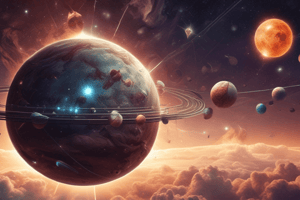Podcast
Questions and Answers
What is the main difference between stars and planets in terms of their light?
What is the main difference between stars and planets in terms of their light?
Stars have their own light, whereas planets do not have light of their own and get light from the sun.
What is the path of a planet's movement around the Sun called?
What is the path of a planet's movement around the Sun called?
Orbit
What is the movement of the Earth around the Sun called?
What is the movement of the Earth around the Sun called?
Revolution of the Earth
Why can't we see other stars during the day?
Why can't we see other stars during the day?
What is the name of the group of heavenly bodies that includes the Sun, the Moon, stars, and planets?
What is the name of the group of heavenly bodies that includes the Sun, the Moon, stars, and planets?
What is the term for the heavenly bodies that orbit around planets?
What is the term for the heavenly bodies that orbit around planets?
What is the name of the most well-known dwarf planet?
What is the name of the most well-known dwarf planet?
What is the term for the small heavenly bodies found between the planets Mars and Jupiter?
What is the term for the small heavenly bodies found between the planets Mars and Jupiter?
What is the main source of light for the heavenly bodies in the solar system?
What is the main source of light for the heavenly bodies in the solar system?
What is the collective term for the sun and the planets that revolve around it?
What is the collective term for the sun and the planets that revolve around it?
Flashcards are hidden until you start studying
Study Notes
Observing the Sky
- On a clear night, we can see many stars in the sky that are far away from the Earth.
- Some stars are prominent, while others are tiny and faint.
- Many stars twinkle, but some do not.
Heavenly Bodies
- The sun, moon, stars, planets, and other objects in the sky are known as heavenly bodies.
- The sun and moon are relatively close to the Earth, and we can see their round shapes clearly.
Stars
- Stars are heavenly bodies that twinkle.
- Stars have their own light.
- The sun is a star, but it appears big and brilliant because it is closer to us than other stars.
Planets
- Planets are heavenly bodies that do not twinkle.
- Planets do not have their own light, but get light from the stars.
- Planets revolve around a star and rotate around themselves.
The Solar System
- Our Earth is a planet that gets its light from the sun and moves around it.
- The movement of the Earth around the sun is called the revolution of the Earth.
- There are seven other planets that revolve around the sun: Mercury, Venus, Mars, Jupiter, Saturn, Uranus, and Neptune.
Orbits and Paths
- Each planet in the solar system revolves around the sun along a specific path called its orbit.
Other Heavenly Bodies
- Satellites are heavenly bodies that revolve around planets and get their light from the sun.
- Dwarf planets are smaller heavenly bodies that revolve around the sun independently.
- Asteroids are small heavenly bodies that revolve around the sun, found between Mars and Jupiter.
Studying That Suits You
Use AI to generate personalized quizzes and flashcards to suit your learning preferences.




